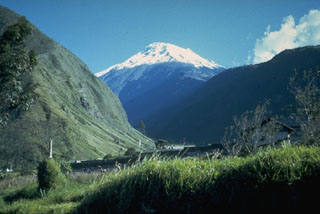Report on Tungurahua (Ecuador) — 24 July-30 July 2013
Smithsonian Institution / US Geological Survey
Weekly Volcanic Activity Report, 24 July-30 July 2013
Managing Editor: Sally Sennert.
Please cite this report as:
Global Volcanism Program, 2013. Report on Tungurahua (Ecuador) (Sennert, S, ed.). Weekly Volcanic Activity Report, 24 July-30 July 2013. Smithsonian Institution and US Geological Survey.
Tungurahua
Ecuador
1.467°S, 78.442°W; summit elev. 5023 m
All times are local (unless otherwise noted)
IG reported that activity at Tungurahua remained high during 24-30 July. Although cloud cover often prevented visual observations of the crater, plumes were observed almost daily. Roaring was also regularly reported. On 24 July an ash plume rose 5 km above the crater and drifted WNW, causing black ashfall in El Manzano (8 km SW), Choglontus (SW), Puela (8 km SW), Cahuají (8 km SW), and minor ashfall in Cevallos (23 km NW), Quero (20 km NW), and Mocha (25 km WNW). On 25 July ashfall was reported in El Manzano, Choglontus, and Cahuají. An explosion at 1835 generated an ash plume that rose 2 km and drifted W. The next day windows vibrated at the Tungurahua Observatory (OVT) in Guadalupe (14 km N). Minor amounts of ash fell in El Manzano, Choglontus, Puela, Mocha, and in the sectors of Guaranda (65 km WSW), Salinas, and Guanujo (65 km WSW). Overnight during 26-27 July Strombolian activity ejected blocks that rolled 300 m down the flanks. At 1947 a strong explosion vibrated windows at OVT and in El Manzano and Pillate (8 km W). An ash plume rose 2 km and drifted WSW; minor ashfall was reported in Bilbao (W), Quero, and Mocha. Later that day ash emissions rose 500 m and drifted SW.
Activity increased on 28 July; at 0626 a higher number of long-period earthquakes were detected, explosions became more frequent and larger, blocks were ejected, and ash emission rose from the crater. An explosion at 0723 generated a small pyroclastic flow that descended the N flank. Ash fell in Choglontus, El Manzano, Mocha, and Tisaleo (29 km NW). Activity remained high the next day; ash plumes rose 2 km and drifted WNW. During 28-29 July and ashfall was reported in Mocha, Quero, Tisaleo, Cevallos, and Pillate.
Geological Summary. Tungurahua, a steep-sided andesitic-dacitic stratovolcano that towers more than 3 km above its northern base, is one of Ecuador's most active volcanoes. Three major edifices have been sequentially constructed since the mid-Pleistocene over a basement of metamorphic rocks. Tungurahua II was built within the past 14,000 years following the collapse of the initial edifice. Tungurahua II collapsed about 3,000 years ago and produced a large debris-avalanche deposit to the west. The modern glacier-capped stratovolcano (Tungurahua III) was constructed within the landslide scarp. Historical eruptions have all originated from the summit crater, accompanied by strong explosions and sometimes by pyroclastic flows and lava flows that reached populated areas at the volcano's base. Prior to a long-term eruption beginning in 1999 that caused the temporary evacuation of the city of Baños at the foot of the volcano, the last major eruption had occurred from 1916 to 1918, although minor activity continued until 1925.
Source: Instituto Geofísico-Escuela Politécnica Nacional (IG-EPN)

